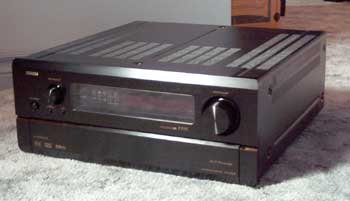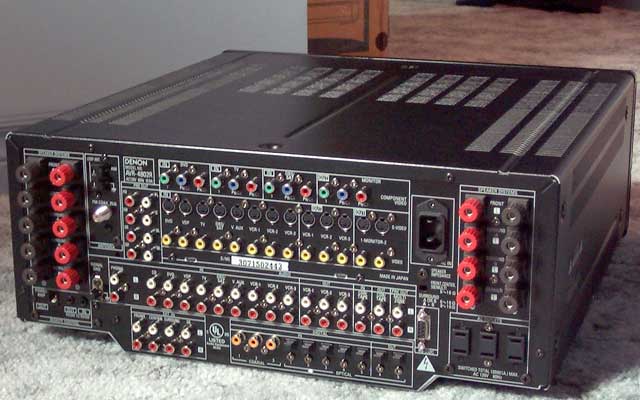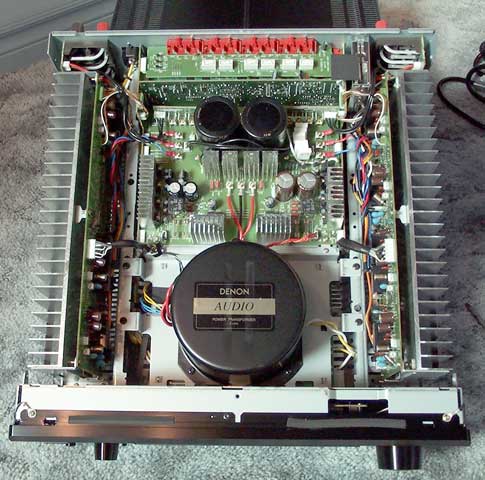|
||||
|
Introduction In the seemingly lucrative midrange receiver market ($1000-$2000), product zeal is fostered. The price point just happens to be one which is, for most of those buying, a substantial investment. Its natural then that an enthusiast will "defend" their choice, regardless of how or why it was made. No one wants to think they could have made a better purchase. While I've tired of fighting the misinformation of internet forums, I do still lurk on them and noticed: Whenever someone mentions or suggests an A/V receiver to someone else, a third party always seems to show up with the proverbial "my Denon is better" comment. Truth is, I've never spent any real time with a Denon beyond the floor show presentations at trade shows. When our Editor-in-Chief told me he was having a Denon THX Ultra2 unit sent up to Canada for me to go over, I was thrilled to finally give them a shakedown and see what substance there was to this loyalty of owners. The Design As we've come to expect with this class of A/V, receiver, the 4802R's back side is solid with speaker jacks and I/O connections. As you can glean from the photo below, spade lug speaker connections are not possible, and I would not want the headache of bare wire in such tight quarters. Thank haeven for bananas! The build quality is excellent with solid panels and damping pads at the seams to eliminate any rattling or ringing.
There are 11 inputs (including one phono level input), 5 of which have rec-out lines, 8 of which have corresponding composite and S-Video lines. The three coax digital and five optical digital inputs can be assigned to any component. Three component video lines are pre-assigned, and a 7.1 analog input is provided. The full 7.1 pre-out set is complimented by a pair of optical digital outs and monitor lines for Main and Zone2 operation. IR I/0 and antenna connections round things out. The RS-232 port is for control of the unit by a central system, not software updates. Like some other 7.1 receivers we've been seeing, the 4802R gives the option of being a 5.1 receiver, using the Surround Back channels as a Stereo Zone2 instead. I like the detachable power cord, not because I buy into the hocus pocus of exotic ones, but because it makes setting up a unit like this in a rack that much easier. Also, if the cord is not long enough, you can replace it with longer one rather than use extension cords.
Lifting off the cover, the 4802R might very well pass for a dedicated power amplifier, as all the "receiver" stuff is hidden underneath. The torodial transformer is backed up by a pair of decent capacitors, and a couple of big fuses would suggest this thing can indeed pull something substantial from the wall. Denon quotes it as 7 x 125watts, full audio band, into 8 ohms, but does not on paper suggest with how many channels driven (I'd say two). THX has been walking a fine line with me. While their design manual is, as far as I'm concerned, the bible of home theater audio, more and more we're finding areas that they "let slide". Case in point: color coded multi-channel I/O and speaker jacks. Precious few THX units actually have this, even though it is supposed to be a "requirement". The 4802R is not one of the few good exceptions. Trivial you say? Try hooking up a 4802R hunched over a rack. You cant see the labels, and the speaker jacks are asymmetrical: While the two columns of jacks start with front left and right, the next pair is Center and Surround A Left. The rest are correspondingly uncorrelated. Also, THX has always represented that they approve (on some level) the User Interface, usability, and ergonomics of a product. If in fact that is true, they should be embarrassed by the 4802R. Read on. The Functions After coming down hard on the poor software of the Yamaha Z1 a month ago, I hate to say it, but we've found one which rivals its failure in one important aspect. To set up the AVR4802R, you need the remote, as there is no copy of the "setup" button on the front of the unit, not even under the drop down door. That's a strike against it right off the bat. What has me absolutely up in arms is that you MUST connect a TV to the Denon to set it up or make changes to its set up. Now don't misunderstand here: I'm sure an impromptu survey of 4802R owners would show they all have a TV in the room, but one should never have to make that connection. We at Secrets have always advocated going straight from source to TV with video signals. It's a darn nuisance to have to switch your TV to a spare input just to see what you are doing with the Denon. And it's not as if the on-screen offered some sort of rich, graphical UI: You are only dealing with one line at a time, something which would have worked fine on the front panel. A TV is also required when making simple mode option changes when using the remote (such as Dynamic Range Control or the choice of Pro Logic II Cinema and Music). Yet these same things can be changed without a TV if you walk up to the unit and use associated buttons under the cover on the front. Bizarre. Anyone paying close attention may have noticed there are nine pairs of speaker binding posts. No, this is not a 9.1 processor! There are two outputs for each side surround channel so that you can have both dipoles and monopoles in that position and choose between them (or both at the same time). Either way, there is still only one amplifier for each side. While I am perfectly satisfied with how my dipoles treat 5.1 music, I know there are many who are so internally conflicted over it, they wish they could have both dipoles and monoploes and choose between them. With the Denon, you can. The choice of A/B/Both is made according to playback mode though, with all Dolby Digital and DTS modes being ONE choice. The other choices are THX, Widescreen (a Denon DSP Mode), 5/7Channel Stereo, DSP Simulation (Stadium, Hall, etc.), and the 7.1 Analogue In. If you want to have one type of surround speaker for Pro Logic II Music and the other type for Pro Logic II Cinema, the only way to do it is to set THX to use the dipoles and Dolby Digital/DTS to use the monopoles. Then you would use the THX mode to engage the dipoles. On a related note, the choice of Pro Logic II Music vs. Cinema is a single, global choice. This means that if you are watching TV and have Pro Logic II set to Cinema, when you switch to the CD player, it will still be set for Cinema. You'll have to change it to Music (remember you need a TV to do so), but then the next time you watch TV, it will be set to Music and you'll have to change it back to Cinema. The "workaround" is to make use of the fact that THX only operates over the top of Pro Logic II in Cinema mode. Set Pro Logic II to Music mode and use THX on any input you would rather Pro Logic II be in Cinema mode for. While you cannot disengage THX's Re-Eq independent of the THX Modes, you can engage "Cinema EQ", presumably a Re-Eq clone, to non-THX surround modes. There are no other EQ features and no Academy Mono filter. The Denon does properly detect EX flags, and this can be defeated at your option. You can also force the use of the surround back speakers in one of two ways: Forced EX decoding (called "Matrix On") or you can have them double the side surrounds (called Non-Matrix). This is excellent. Further, there is a single dedicated button on the remote which will cycle through these options if your setup choice is not appropriate for the task at hand. Like 99% of SSPs, the 4802R ignores the SurrEnc flag in two-channel Dolby Digital. Although the volume is the digitally controlled analog type, Denon takes no advantage of it. There is no option to choose a power-on volume level, nor is there any means of selecting a max volume setting. There is no choice for X dB attenuation on the mute, and inputs do not have any sort of level trim. There are three levels of Dynamic Range Control beyond none, and it's interesting that you cannot engage DRC when in THX mode. Each pair of speakers can be set to "Large" or "Small" (center and surrounds can also be set as "None"). The crossover is the standard THX set of slopes (4th low pass, 2nd high pass) at your choice of frequency from 40 Hz - 120 Hz (20 Hz increments). The Denon naturally employs the THX standard voltage level of test signals for speaker level calibration. There is an A/V Sync delay setting which is unique to each input, range of 0-200ms. This is exactly what we've been asking manufacturers for! There is a "Fader" adjustment, not at all unlike the front/back fader in a car audio system. I can think of no situation where this would be useful, and again, you need a TV hooked up to see what you are doing with it. Time alignment is critical for proper operation of a multi-channel audio system, and Denon gets it right. Under "Speaker Delay" in the setup menu, you can choose feet or meters, give it the distance to each speaker (including subwoofer), and the system calculates the differences in distances and applies the appropriate delay to the various speakers. The front panel offers three level of illumination which are hardly distinguishable from each other. The lowest setting is not nearly dim enough, and the Denon will distract in a blackened home theater. You can turn it off altogether, but the small array of bright lights (used to indicate input format and such) stays on. They are pointless, as when viewed from more than 3 feet, you cannot see the labels, and these lights thus become arbitrary. The Denon remote is a fairly decent universal which was able to control our variety of components without problems, and included many functions most muti-function remotes miss, such as "Setup" for both our Sony TV and Yamaha (Matsushita) DVD Player. The buttons are a good size, logically placed, and for the most part are shaped to distinguish them, but not always (chapter skip and scan for example are exactly the same size so you have to memorize which one is above the other). I guess I'm spoiled by the touch screen of my Pronto Neo: Even with backlighting I found the Denon remote hard to use in the dark as many of the important labels are not on the buttons themselves (but silk screened above them). Selecting an input on the Denon for example, is impossible in the dark. The 7.1 channel input is a pure analog feed. There is no option to digitize it for the sake of bass management or time alignment. The Zone2 outputs are a true Zone2 in that they can monitor a different source from the main zone. The Headphone jack is a pure slave to the main zone. It cannot monitor Zone2 and shares/mirrors the main zone volume, cutting out the main zone when plugged in. The Sound The Denon AVR-4802R sound overall is par. By that I mean it's not remarkably good or poor, and thus, average. It is clean and clear without any sort of detectable distortion, but it does come across as "sharp" or "bright". Depending on your speakers, this may or may not be an issue. As for power, there is subjectively plenty to spare. I used it with the true 4 ohm load of my M&K MPS2510 Pro monitors and it never audibly ran out of steam or stressed on loud passages of harmonically complex material. It's worth noting though that as you change from a surround mode to stereo, you can hear relays clicking inside, presumably making more juice available to the front two channels when they are the only ones in use. Personally, as of Pro Logic II, I have no use for stereo. Click Here to Go to Part II - On the Bench and Conclusions
|
||||




